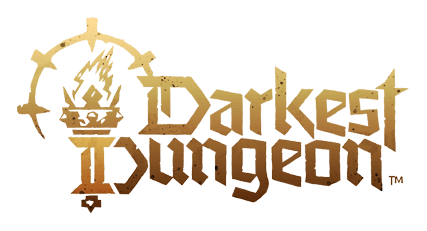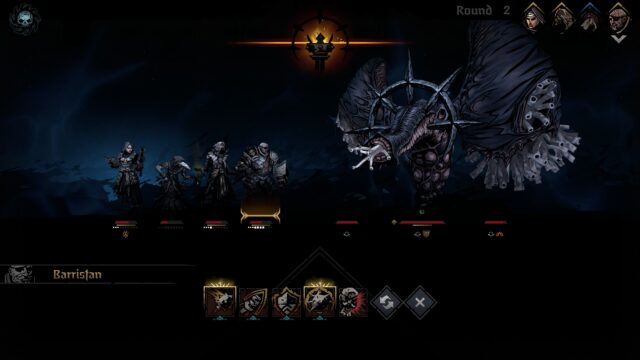Darkest Dungeon II Review
A Treasured Nightmare
Some games build a reputation for being difficult, and this can be a significant challenge to balance that difficulty in a fresh way that still feels true to the experience. Red Hook Studios took the familiar side-view roguelite tactical gameplay of its first title, blending it with a new travel perspective and different mechanics to give a fresh experience to Darkest Dungeon II. Brutally hard combat still pervades every step of the way, needing careful strategy and some luck to survive making every step forward feel like an accomplishment. Even the best laid plans can be waylaid by random chance though, so for every bit of strategy utilized there’s still a nail-biting conclusion to make sure it works.
The story and world building of Darkest Dungeon II has small compelling stories littered throughout the experience. With the focus still on gameplay, this leaves a few paragraphs of backstory that can be found for each of the twelve playable heroes in the game. Four of these heroes hop in the stagecoach and travel through ruinous regions to reach the Mountain. The Mountain and these backstories are where the nameless player and the heroes confront their decisions that have led to crumbling psyches born from madness, anger, frustration, and guilt that they wish to atone for. Every bit of descriptive dialogue is delightfully delivered by the droll Academic, the game’s narrator, voiced again by the returning Wayne June.
A basic run of Darkest Dungeon II will have players traverse through ruinous regions and climb the Mountain to fight a chapter boss. There are five chapters in total that each add a bit more of the player’s backstory while making the route to the Mountain more difficult. This difficulty increase starts with the second chapter, as lair nodes become mandatory due to needing to equip the trophy won from one of them to even fight the Mountain boss. Lairs are multiple fight events against two waves of region-specific enemies and an extremely difficult mini-boss. Surviving these fights isn’t guaranteed as, at the end of the region, players still have to contend with the gatekeeping Oblivion’s Rampart node before making it to the next inn safely. Oblivion’s Ramparts are fights against tough cultist enemies but generally manageable if prepared for properly. The player’s reward for surviving this gauntlet of lairs, dangerous travel, and mini-bosses are chapter bosses that have unique mechanics to uncover. All of this is geared to keep players constantly on their toes as every step feels earned and the feeling of accomplishment for coming away victorious is palpable.
Bringing the players on their journey to the Mountain is their trusty stagecoach, with which players can run over debris to gain extra loot. Each region is a series of connected location nodes with various obstacles in between each one that can cause harm to their stagecoach. These obstacles can become annoying quickly as players deal with combat ambushes, hazardous conditions that effect the stagecoach’s wheels and armour, as well as loathing points. If an obstacle is reached with any part at zero condition, a combat begins and players have to deal with a random party member having to conduct repairs every turn until the fight is over. Loathing points are increased by negative events and reduced by defeating ambushes, monster dens, etc, but if they do reach four then the final boss gains a health boost while other maladies can befall the stagecoach. The stagecoach’s light holds back some of the enemies’ powers, but it slowly decreases, necessitating being boosted through assistance encounters, oasis nodes, or items to reduce how frequently enemies gain advantages. Balancing these travelling disadvantages is another layer of strategy added to Darkest Dungeon II, that adds to its theme of overcoming adversity in the face of overwhelming anguish.
Helping offer respite between these ruinous regions are inns. Inns give players much needed health boosts and allow them to replace any fallen comrades with random sidelined heroes, while also allowing them to make purchases or use skill mastery points. These skill mastery points are obtained from combat and upgrade any hero’s ability to a better version once. Currency is sparse in Darkest Dungeon II and is split between relics and baubles. Relics are used to buy combat and inn items, while baubles are used for stagecoach upgrades and trinkets. Heroes can equip one combat item and two trinkets giving a lot of opportunity for experimentation due to the large amount of them that can be unlocked and how infrequently the best ones can be obtained in each run. Inn items include ways to boost inter-party relationships, a key mechanic that influences whether heroes can counterattack or heal stress, and provides a host of potential positive boons. There are things that can cause two heroes to have a negative relationship as well, which would be wise to avoid. They can add to their stress, force some skills to be equipped that may not help the player, or even cause debuffs for the other party member every time that ability is used.
Stress is an additional mechanic that players have to juggle for their heroes. Too much stress and characters are likely to have a meltdown, which causes a drop in party relationships and a substantial health drop. Rarely, characters can reach a high stress level and become resolute, gaining an opposite bonus instead, but planning for this is foolhardy due to a slim chance of it occurring. Healing stress isn’t that easy as there are few abilities that do so; inn items help somewhat, but the best way to combat it is with positive relationships between heroes. Luckily, health dropping to zero is not an automatic death; instead that hero is given an a death’s door state, and any subsequent damage received can become a deathblow. However, restoring even a single point resets the process. Both meltdowns and death’s doors can cause lots of anguish for players as one bit of bad luck can cause everything to fall apart quickly.
Mismanaging a party or just getting unlucky in combat will quickly lead to game overs. When this happens, players can use accumulated candles, from accomplishing varying tasks in the game, for upgrades to make the next run easier. Candles are used at the Altar of Hope to unlock new items, boost hero abilities, and unlock new ones. Unlocking things is a blessing and a curse as the shops still have the same very limited number of selections, leading to sometimes having nothing useful to use currency on. Earning candles gives players a sense that something is gained from a failed run, but only getting minimal upgrades for several hours of work is a tough pill to swallow.
Each of the heroes in Darkest Dungeon II has a variable smorgasbord of options to choose from to make them all powerhouses in their own way. Just how strong though is based on equal parts player choice and luck. Players can choose their equipment, which of the twelve skills to use, and even one of four paths to undertake that can boost some abilities. Each character is automatically given two quirks at the start of a run: one positive and one negative. Some quirks are small like a refusal to eat anything fungal, but others are game altering like a head wound that causes the character to be dazed half of the time, which moves their turn to the end of the round. Players can gain new quirks at inns, but these are more likely to be negative than positive, and throw another wrench in a player’s carefully crafted plans. Negative quirks can be eliminated at Field Hospitals for a price or with the use of certain items. Juggling quirks, relationships, and the stagecoach can all feel overwhelming at first, but the key is to ignore the minor inconveniences while managing the worst situations as best as possible.
Helping mitigate the frustration and boost some luck is the travelling flame. Travelling flames help with things like positive relationship chance, death’s door survival, flame management, among many other perks and are available for free at the first inn players travel to. These boosts only get stronger with each failed run, gaining more perks, to a max of five, until a chapter boss is defeated. Players may feel like a run is doomed when a member or two of their party is killed, but that isn’t always the case as the random replacements can end up being game savers in their own right. As unfair and random as the game can feels at times, players will come to understand that it is really finely balanced and that are still many paths to victory and rewards for good planning, though a bit of luck does help.
Darkest Dungeon II has a very distinct Gothic look to it enhanced by harsh pencil-like dark lines that permeate each design. Regions accentuate this, as they evoke different styles of desolation as it draws upon fire, rampant vine growth, and plagued farmlands to name a few. There are many little details in each screen, image, and combat animation that there’s something to appreciate on each viewing. While taking in the visuals, players will hear striking violin work as a part of the background music to keep tension slowly building to reach combat. Mixing in with this dreary atmosphere is the delightful voicework of Wayne June that mixes with the wailing sounds of pain, anguish, and fear to pierce through the background music and set the macabre tone perfectly.
When a game is successful it can be easy to just make a few changes and call it a day for a sequel. Altering the formula with how traversal works and adding in new ways of making the game feel both punishing and fair is what makes Darkest Dungeon II exemplary. With so many different options of making things work it is easy to get lost in this world for one more run. Those that stick past the many fallen runs will find a game that shines by not having players learn to run from walking, but rather how to stand battered and bloody after crawling and fighting through everything the game throws at them. This game is a well-designed gem for any brave enough to enter its depths.
Disclosure: This review is based on a free copy of the game provided by the publisher.


Stunning visual flair
Delightfully droll voicework by Wayne June
Plenty of options to keep things balanced
Addictive combat that keeps players on their toes
A palpable sense of accomplishment for success
Failed runs often take a long time to complete
Random chance can feel unfair at times









Recent Comments